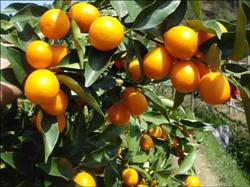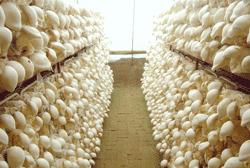How to reduce pollution in Spring Tremella cultivation

The cultivation of Tremella fuciformis in spring is mostly caused by green mold, and some of them are polluted by Rhizopus and Mucor, while Alternaria is rarely. Green mold, Mucor and Rhizopus often occur at the edge of the inoculation hole of the bacterial bag, or when the two-hole bacterial circle joint occurs 10 days after inoculation, it appears in the front of the hyphae and in the bag wall. Green mold also occurs on the fruiting body. Make the ear pieces mildew. Alternaria often occurs in the gap at the mouth of the bag. The main causes of pollution are incomplete sterilization of material bags, lax aseptic operation, perforation of bag membrane, impure contamination of bacteria or damage of environmental pollution, etc. To avoid miscellaneous bacteria pollution, the key to do a good job in the following aspects: 1, purify the mushroom room environment: often clean up environmental hygiene, and sprinkle lime powder disinfection: room cultivation before strict disinfection and sterilization, put an end to pollution sources. 2. Select raw and auxiliary materials: cottonseed hull and wheat bran are required to be free of caking, mildew and deterioration, and sterilized in the hot sun, and the quality of the cultivation bag is tested in advance. 3. Standardize the production of bacterial bags: the water content of the culture material is no more than 60%, and the time limit for packing the stove is not more than 6 hours to prevent the material from becoming sour. Sterilization should be kept at 100 ℃ for 24 hours without cooling. 4. Adhere to aseptic operation: thoroughly disinfect and sterilize the inoculation room, select qualified disinfectants, use super clean essence, add water 10m / m 20kg per bag, spray space and bed, site, then use disinfection box not less than 5g per cubic meter, sterilization time 1 hour. Inoculation requires alcohol lamp flame. 5. The strain should be strictly checked. Selected strains, Tremella fuciformis in spring requires stronger ash hyphae to avoid low-temperature ash removal after inoculation. Copy bacteria to pay attention to disinfect according to the seed box, transport bacteria to prevent broken bottles from being unplugged. 6. Pollution bag treatment: pollution bags harmed by miscellaneous bacteria should be treated differently: mild pollution should be bagged, spread controlled, and then sterilized and inoculated; for heavy cases, break the bag and mix well with 1% lime, and then spread out after 24 hours of boredom, for next reuse and cultivation. If the fruiting body is contaminated by green mold, it should be harvested in advance, and the ear base should be rubbed with the liquid liquid on PH8 lime to control the spread. Second, eliminate pests 1. Bacteria mosquitoes are mainly small bacteria mosquitoes. Prevention and control measures: regular cleaning of environmental hygiene, disinfection with lime powder; installation of screen for doors and windows, regular spraying of pyrethrum liquid or 2000 times solution of Yitaibao on the Internet; installation of black light trapping in the room. During the peak period, pesticides are limited to low-toxic and low-residue varieties, such as Regent 3000 times liquid spraying, mosquito-repellent incense can also be ignited or crushed and fumigated with sanitary pills. 2. Mites are also called fungus lice, and there are many kinds of mites, including mite and acaroid mite. Prevention and control measures: raw material warehouse should be far away from the mushroom room, exposure before use; the surrounding environment should be cleared clean; disinfection before opening of the bacterial bag, spray with 73% propargite 3000 times liquid one day in advance, then set the room temperature to 20 ℃, close the doors and windows for thorough disinfection of the empty room, and then remove the smell of drug residue, open the tape. When mite damage occurs in the early stage of fruiting body growth, fresh tobacco leaves can be laid next to bacterial bags to induce mites to gather tightly on the leaves, and then taken out and burned to death: tea seed cakes can also be ground into powder, stir-fried until oil is fragrant, sprinkled on the harmful parts of mites, and then scalded to death with boiling water. In the case of no choice, you can use 20% diformamidine EC 1000 Mel 1500 times liquid spray to kill. 3. Nematode control methods: culture medium should be sterilized thoroughly, water source should be tested, mushroom room should be strictly disinfected in advance, spraying water should not be too wet, and pay attention to ventilation. If nematodes are found in the mushroom room, use 0. Spray 5% lime water or 1% salt water for 3 times on a cool day, and disinfect the floor of the mushroom room with lime powder. During the long ear period, 1% glacial acetic acid or 25% rice vinegar solution can be used to sprinkle the disease spot. Third, the prevention and control of diseases of Tremella fuciformis is divided into infectious diseases and non-infectious diseases, infectious diseases are caused by pathogens, non-infectious diseases, some are caused by physiological diseases, and some are caused by out of control of production management. The main results are as follows: 1. Powdery mildew is also called white rot, and the pathogen is Alternaria. Prevention and control measures: strengthen the ventilation and humidity of the mushroom room, spray lime-sulfur mixture when young ears occur, and harvest in advance, scrape off the roots with a sharp knife, the ear base can be smeared with 4% carbolic acid solution, and fumigated with 50% mildew powder in the evening. 2. Fusarium solanum, the pathogen of ossified disease. Prevention and control measures: raw material exposure, ingredient water content should not be too high 60%; before opening opening, 1000 times dichlorvos EC is sprayed and sterilized; after cutting film and expanding hole, the space humidity is not more than 80%; when young ear stage occurs, PH8 lime supernatant can be sprayed, harvested ahead of ear stage, soaked in 5% lime water and then processed and dried. 3. Prevention and treatment of black pedicel head; it is better to culture bacteria no more than 28 ℃, cut film and expand acupoints in time to increase oxygen, promote mycelium normal metabolism; spray water less and frequently, not excessive, to prevent stagnant water around ear base; pay attention to ventilation and ventilation at the same time. 4. Prevention and treatment of rotten ear: prevent the culture medium from becoming sour, pay attention to heat dissipation after material bag sterilization, and prevent overtemperature by bacteria culture. Long ear stage control 23 ℃ 25 min, timely ventilation, appropriate amount of water spray, space relative humidity 85% 95%. Young ears are found to be rotten ears removed and dug in time, wiped with lime water, and then sprayed with 1000 methyl thiocarbamate solution to control; ear mildew rot is harvested in advance, and 25% thiram 1500 times solution is used to control the spread of pathogens.
- Prev

Types of organic fertilizers commonly used in fruit tree production
Organic fertilizer, also known as farm fertilizer, is commonly used in fruit production, such as compost, ring manure, stable manure, green manure, cake fertilizer, river mud, poultry manure, human feces and urine, soil manure and so on. Most organic fertilizers need to be decomposed by microorganisms before they can be absorbed by the plant roots, so they are also called "delayed fertilizers" and can be used as base fertilizers.
- Next

A New technique for cultivating Pleurotus ostreatus in whole Plant of Maize
Pleurotus ostreatus is easy to show buds, that is, it is not normal at both ends of the bag, but in the middle of the bag, which has a great effect on the yield. Note that the following four points can effectively prevent the emergence of buds in Pleurotus ostreatus. First, the filling of bacterial bags should be standardized. Try to pack the material bag evenly and tightly, leaving no space, especially by hand. ...
Related
- Fuxing push coffee new agricultural production and marketing class: lack of small-scale processing plants
- Jujube rice field leisure farm deep ploughing Yilan for five years to create a space for organic food and play
- Nongyu Farm-A trial of organic papaya for brave women with advanced technology
- Four points for attention in the prevention and control of diseases and insect pests of edible fungi
- How to add nutrient solution to Edible Fungi
- Is there any good way to control edible fungus mites?
- Open Inoculation Technology of Edible Fungi
- Is there any clever way to use fertilizer for edible fungus in winter?
- What agents are used to kill the pathogens of edible fungi in the mushroom shed?
- Rapid drying of Edible Fungi

